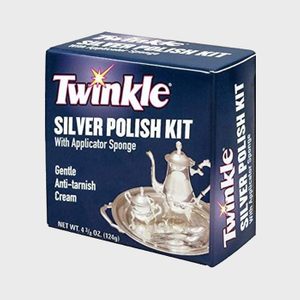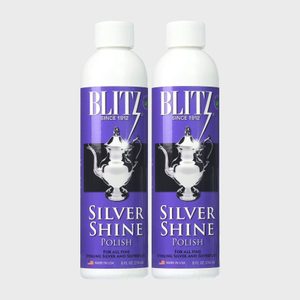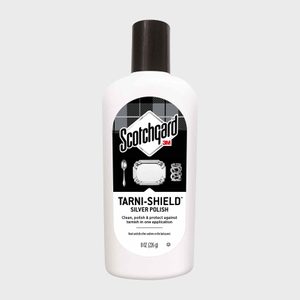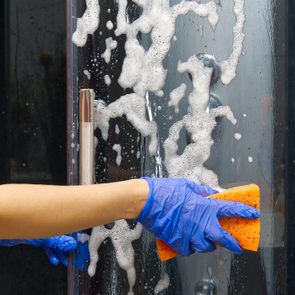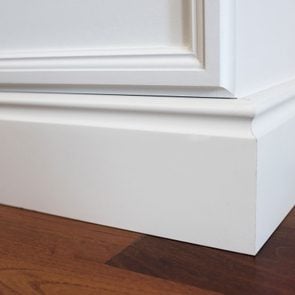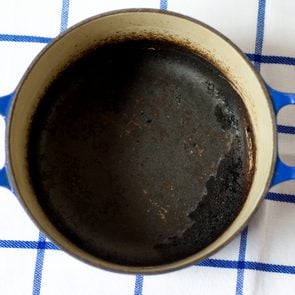How to Clean and Polish Silver to Restore Its Shine
Updated: Feb. 18, 2024
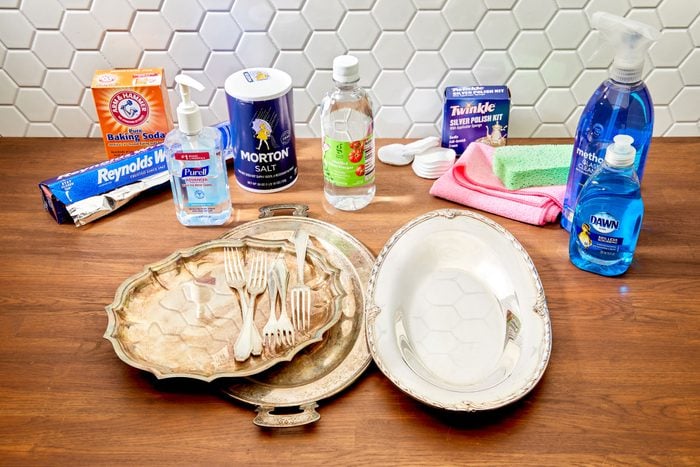
Stop hiding the family silver in the closet. This guide to how to clean silver targets tarnish with simple steps and household staples.
As beautiful as silver can be, it takes a little extra care. That’s why so many of us set it aside for special occasions. But we don’t need to! Learning how to clean silver may seem intimidating, but it’s a lot easier than you may think. So when you’re tackling kitchen cleaning, be sure to add “polish the silver” to your regular cleaning schedule. Then put those items to good use.
“Don’t just break out the flatware for holidays,” says silver restorer and conservator Jeffrey Herman. “Use it every day.” He says regular use can help silver stay cleaner while developing its patina. As founder of the Society of American Silversmiths, he should know. Take, for instance, silver flatware. Washing it daily with mild dish soap and a cellulose sponge forestalls tarnish.
So if knowing how to clean silver is the only thing between you and dining like royalty, put this task on your cleaning checklist. Then follow the steps below to restore family heirlooms to their original luster.
Get Reader’s Digest’s Read Up newsletter for more cleaning, humor, travel, tech and fun facts all week long.
On This Page
Why does silver tarnish?
In the world of silver, tarnish happens. It’s caused by a chemical reaction between silver and the elements. Very often, sulfurs in the air are to blame, but acids can impact silver as well. Those can come from food, paper and even your skin. It’s one of the reasons experts who handle silver wear gloves.
And when silver is exposed to humidity, the darkening process accelerates. All this adds up to the need for a deeper clean from time to time. Think of it less like daily floor cleaning and more like the occasional spring cleaning.
How often should you clean silver?
Determining a cleaning schedule for silver is more nuanced than figuring out how often to clean your bathroom, kitchen or other high-traffic areas of the house. According to Herman, it may require polishing only a couple of times a year. In fact, you’ll want to avoid deep-cleaning too often to protect the silver.
How you store the silver also determines how quickly tarnish will collect. Less air exposure and humidity equals less work for you.
How do you know the time is right? Start by looking for a light yellow cast. And if darker tarnish blossoms, it’s time to gather the supplies.
How to clean and polish silver
There are several ways to take silver from tarnished to gleaming. With each, certain chemical reactions help lift the tarnish from the surface, exposing the shine.
Regardless of the method, there are a few things that will make cleaning and polishing successful. Use the least-aggressive methods first, and pick products that won’t scratch the metal. Remove rings before cleaning to avoid scratching the surface, and keep a bin and/or towel beneath the silver to cushion it. Hold the body of the silver, not smaller pieces that extend and can snap off. And remove any traces of older polish by running the item under warm water and lightly tapping them out before proceeding with the cleaning.
Finally, don’t jump right to polishing. Even darkened silver starts with a simple soap-and-water cleaning before turning to polish and elbow grease.
What you’ll need
Depending on the method you choose, you’ll need some of the cleaning supplies below.
- Nitrile gloves
- Cotton makeup pads or cotton balls
- Cellulose sponge
- Soft towels or microfiber cloths
- Dishwashing soap
- Hand sanitizer
- Plant-based, ammonia-free glass cleaner
- Silver polish
- Aluminum foil
- Large, flat pan with sides
- Distilled white vinegar
- Baking soda
- Table salt
The quickest way to clean silver
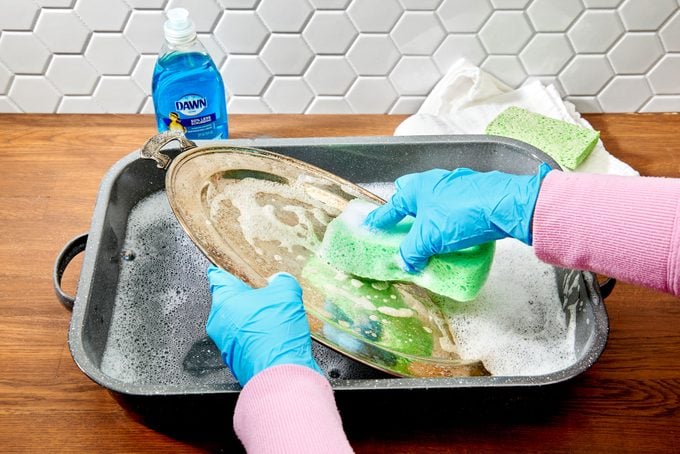
How do you clean silver if time is short and houseguests are on their way? Herman says this method is quick and easy.
Supplies:
Directions:
- Put on nitrile gloves to prevent your fingerprints from affecting the silver.
- Wash the item with a damp sponge and mild dish soap—gently, as if you’re learning how to clean a sink or another sensitive metal.
- Rinse it under warm water.
- Dry it with a clean cotton cloth. That removes grime and possibly tarnish.
Pro tips: Quick cleaning can work on any silver, but if time is precious, focus on smaller items. Regular washing with mild soap and water—stick to cellulose sponges to avoid scratching the silver!—helps prevent dirt buildup and tarnish.
How to clean tarnished silver
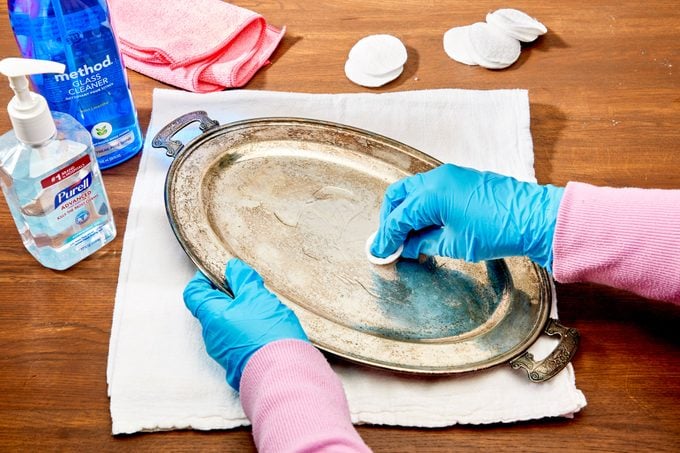
Want to give your silver a deeper but still speedy clean? Follow the steps below for both large and small silver items.
Supplies:
- Nitrile gloves
- Dishwashing soap
- Cellulose sponge
- Cotton towel
- Hand sanitizer
- Cotton pads or balls
- Plant-based, ammonia-free glass cleaner
- Microfiber cloths
Directions:
- Wearing nitrile gloves, wash the silver with a damp sponge and mild dish soap.
- Rinse the item, then dry it with a cotton cloth.
- Apply hand sanitizer.
- Using cotton pads or balls, wipe the hand sanitizer over the silver, concentrating on the grime and tarnished areas.
- Clean one area, then move to the next. Replace the cotton pads as they get dirty.
- Spray glass cleaner onto a microfiber cloth and wipe away the hand sanitizer.
- Rinse the item.
- Dry it with a soft cotton towel.
Pro tip: For hard-to-reach places, consider using a cotton swab.
How to clean and polish silver
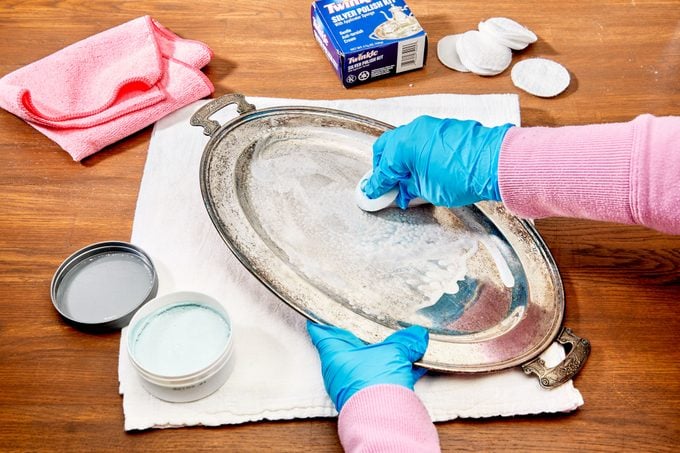
Good news for anyone who wants to learn how to clean silver at home from time to time: If you keep polish handy, the job is a cinch. You have your pick of nonabrasive polishes—Twinkle and Blitz are good options, but Herman recommends the product he formulated, Herman’s Simply Clean Collectors Silver Polish.
Supplies:
- Nitrile gloves
- Dishwashing soap
- Cellulose sponge
- Silver polish
- Soft cotton towels or rags
- Cotton pads or balls
Directions:
- Wearing nitrile gloves, wash the item with a damp sponge and mild dish soap to remove dust, grime and any residual polish.
- Dip a damp sponge into the silver polish. Work the polish into the silver, starting from an outside edge.
- Keep turning the sponge and reapplying polish as the sponge darkens.
- Rinse the sponge every time it’s completely black, and squeeze out excess water before adding more polish (or alternate sponges).
- Rinse the silver under water to clean off the polish.
- Buff it dry with a clean cloth.
You can also try dry polishing if you want to protect part of your item from water.
- Dip a cotton pad in silver polish.
- Clean from the outside edge toward the center.
- Use a damp sponge to remove the polish.
- Buff the item dry with a clean cloth.
Pro tips: It is important to remove all polish from the silver, especially in places that come in contact with food. Herman recommends a back-and-forth motion for cleaning, rather than a circular one.
Take care to avoid doing damage while you clean. In other words, to avoid scratches, skip the plastic sponges that come with some polishes. And be sure you’re dealing with silver before you begin. Knowing how to clean silver isn’t the same thing as knowing how to clean silver plate, which has less silver. Take care to limit polish on silver plate—the polish could penetrate the finish.
The best silver cleaners
How to clean silver with baking soda
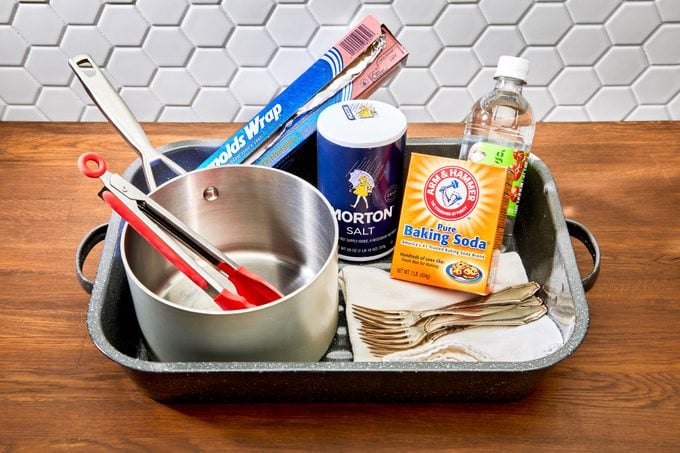
Cleaning expert Leslie Reichert of Green Cleaning Coach teaches how to clean silver flatware with baking soda and other pantry staples. When you use kitchen equipment to give your silver a soak, “the tarnish will jump right off,” she says.
Supplies:
- Baking pan with sides
- Aluminum foil
- Saucepot
- Distilled white vinegar
- Baking soda
- Table salt
- Tongs
- Cotton towel
Directions:
- Line a baking pan with foil, shiny side up.
- In a separate pot, heat enough distilled vinegar to cover your silverware in a single layer. (Consider measuring out the amount you’ll need using water first so you can avoid wasting vinegar.)
- Pour the hot vinegar into the foil-lined pan.
- Add 3 teaspoons each of salt and baking soda to the hot vinegar.
- Place the silverware into the pan and make sure the pieces are touching the foil, not one another.
- The tarnish should come off quickly, but let the silverware soak for a few minutes.
- Remove the silverware with tongs.
- Rinse well to remove any salt and baking soda.
- Dry and buff with a soft cotton towel.
When you’re done, keep the baking soda handy to clean the stovetop.
Pro tip: Experts on antique silver warn against using this chemical reaction to clean silver heirlooms. This method is best for silver tableware that’s not antique. Don’t use it on silver plate—remember, it could eat through the finish. After cleaning, rinse thoroughly, because salt can cause silver to corrode.
Other ways to clean silver
Experts warn that cleaning methods that use acids could damage silver. So if you want to use one of the methods below, test a spot on a small piece of silver before jumping in with both feet. Start with smaller pieces, like flatware, and avoid older pieces and heirlooms. Make sure to rinse them really well afterward to remove the cleaning agents.
- Ketchup: In an emergency, you can use this condiment to polish smaller pieces. Cover the item with a thin layer of ketchup. Let it sit for five to 10 minutes, then rinse really well and dry with a soft cloth.
- Glass cleaner: Spray a microfiber cloth, sponge or cotton cloth with a plant-based, ammonia-free glass cleaner. Wipe away tarnish with a back-and-forth motion. Rinse in warm water and dry.
- Baking soda and vinegar: To clean small silver items and jewelry, mix 1/2 cup vinegar and 2 tablespoons baking soda. Soak items for up to a couple of hours. Rinse them well and dry with a soft cloth.
Can you clean badly tarnished silver?
Regardless of the tarnish level, most silver can be rescued, says Herman. The methods don’t change, but the amount of time invested will. Intricate and larger pieces need more patience and likely more cotton pads.
But no matter the tarnish level, always stick with cotton pads or cotton balls. Never clean anything using a tool with a sharp point or abrasive material.
Don’t worry about cleaning every groove on intricate pieces, he says. Do that, and you risk removing the patina. To judge if the tarnish has been removed, hold the piece against a white piece of paper, which will highlight even the lightest amount of lingering tarnish.
If you’re unsure how to approach badly tarnished pieces, consult an expert who can clean and polish your silver for you. Not only will the expert handle your pieces like a pro, but hiring a silver restorer will leave you more time for other projects, like cleaning your makeup brushes of months (years?) of buildup.
How to keep silver shiny
Once you’ve restored the shine to your silver, there are a few steps you need to take to keep it that way. Consider investing in specially treated flannel storage containers to protect your pieces from the elements, then put the flannel-wrapped pieces in zip-close plastic bags. Alternatively, wrap silver in acid-free paper and include anti-tarnish strips for more protection. Keep the silver dry, and use a silica gel to reduce dampness where it’s stored.
Avoid the dishwasher—the harsh soaps are the enemy of silver. For the same reason, skip chemical dips. Be especially careful with any cleaners that might have grit that can scratch the surface. In place of toothbrushes, use cotton swabs, cotton pads or a natural brush.
Now that you know you may only have to polish your silver once or twice a year, take your time and enjoy the results. It’s worth it.
Sources:
- Leslie Reichert, cleaning expert and founder of Green Cleaning Coach
- Jeffrey Herman, silver restorer and conservator and founder of Herman Silver Restoration & Conservation
- Jeffrey Herman: “Silver Polish Abrasion Ratings”
- Veatge: “What Causes Silver to Tarnish and How to Clean Tarnished Jewelry”

